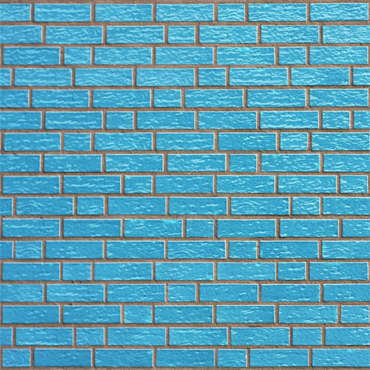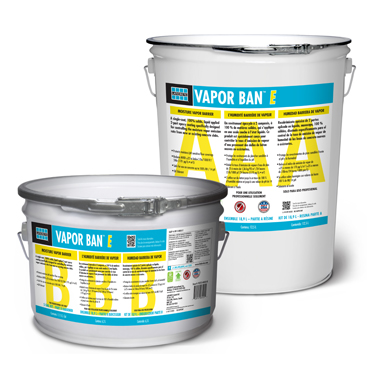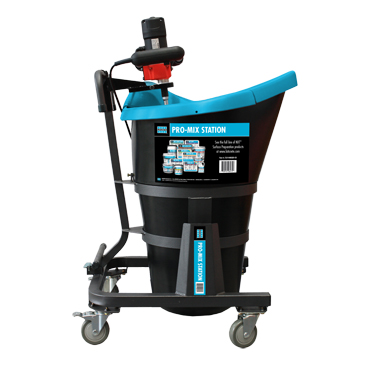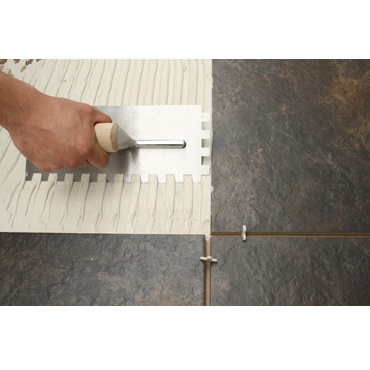LATICRETE Insight for Trouble-Free Conglomerate Tile Installation
Conglomerates or resin agglomerated tiles have become an increasingly popular floor finish in recent years. The reason is simple; they offer a cost-effective alternative to natural stone.
Agglomerate (conglomerate) is a term used to describe a man-made stone or tile product that usually consists of stone pieces and/or aggregates held together in a synthetic binder such as a polyester resin or epoxy resin.
Most agglomerate tile will have the same characteristics as the type of stone used in the matrix, and are frequently classified as granite, quartz or marble. In some cases, the type of binder may have a profound effect on the behaviour and performance of the agglomerate product. Polyester resins have a high Thermal Coefficient Of Expansion and may present problems concerning significant differential movement when installed in exterior installations, such as building façades.
There are thousands of different agglomerate products on the market, and each of these tile types has its own physical characteristics dependent on the type of stone chips or aggregates (e.g. colour and inherent physical properties of the stone), type of binder, the dimensional stability of the aggregate, and the percentage of each material used.
The most widely used agglomerate tiles typically consist of stone pieces mixed into a 4 to 8% polyester resin binder. As the production technology and capabilities of agglomerate tile increases, so do the size, thickness and composition of agglomerate tile. Agglomerate tile can be found in many sizes, with larger formats, such as 900 by 900mm, now commonplace. However, even larger agglomerate slabs are now being produced in sizes of 900 by 1,800mm or greater.
It is important to note that the facial dimensions and thickness of the agglomerate tile have a direct bearing on the dimensional stability of the agglomerate tile. Some agglomerate tile manufacturers issue a table or chart listing which of their products are suitable for use using normal setting materials, which ones require rapid setting materials, and which of their tile products requires 100% solids epoxy setting materials. Later in this article we will explore which Laticrete products are acceptable for each type of installation.
It is important to check with the agglomerate tile manufacturer to verify suitability and acceptability of each agglomerate tile for its intended purpose. For instance, certain agglomerate tiles may not be suitable on an exterior application due to moisture sensitivity, instability of some resin and stone pieces to extreme temperature changes, are not ultraviolet light (UV) resistant, or are not freeze/thaw stable.
It is also a good idea to check with the agglomerate tile manufacturer for their recommendations on setting materials. The manufacturer of the agglomerate tile may also have requirements on the moisture vapour emission rate (MVER) of the mortar bed or concrete prior to installation of their tile, and may even prohibit the installation of their product using traditional sand and cement methods.
It is always a good idea and highly recommended to conduct a test area in the actual conditions, and with the specified installation materials, to determine acceptability of all materials and conditions.
Agglomerate tiles are manufactured in a broad array of colours and can be engineered to offer technical benefits, notably improved mechanical and physical properties such as scratch resistance and flexural strength.
They are marketed under a bewildering range of generic names, including conglomerates, resin agglomerated tiles, reconstituted stone, re-composed stone and, particularly in the USA, as engineered stone.
This manufacturing process combines a mixture of crushed marble or stone chips and powdered stone, together with colours and polyester resin as the binder. The dry materials are combined and the resin and hardener added to make a mass that is placed in an enclosed chamber and put under negative pressure, using a vacuum pump, to remove air bubbles.
After the polyester resin reacts, it binds the entire mass into a solid block that is then cured and sliced into tiles and slabs. These tiles and slabs are then further processed by polishing the front and grinding the back to a uniform thickness. Slabs can also be cast by this process, and will be processed by grinding and polishing to produce nished slabs with the appearance of marble or other stone, but at a more economical cost than natural stone cut from block.
Normally, the back of all the agglomerated stone is passed through a grinder to gauge the material to a uniform thickness and to remove all irregular protrusions. The thickness is normally gauged accurately within +/- 1mm.
This conglomerate stone material is used, worked and installed just as natural stone tiles or ceramic tiles. Slabs cut in the larger sizes are used for floors and walls similar to natural granite or marble slabs.
There are two main types of polymer-resin binder used in the manufacture of conglomerate tiles: epoxide or polyester. As we have already seen, typically the ratio of resin binder to agglomerates varies from 4% to 8%, which means, of course, they also contain 96% to 92% agglomerate. It is a general rule that the higher the percentage of resin present, the lower the abrasion resistance. The proportion of resin also affects the tile’s Coefficient of Thermal Expansion.
This is important due to the increasing use of under oor or undertile heating systems, becoming increasingly popular as a heating choice within the UK. When considering a rigid tile nish over UFH, it is important to understand how the heat change affects the different materials employed within the tiling installation.
The Coefficient of Thermal Expansion for a typical constructional sub-floor, such as concrete or cement; sand screed is similar to a cementitious-based tile adhesive. However conglomerate tiles generally have a higher Coefficient of Thermal Expansion.
In simple terms, the tile has a high modulus of rupture, or measure of strength before rupture, and is being ‘restrained’ by the tile adhesive. However due to heating and cooling cycles, a relatively small amount of heat expansion and contraction can exert a high level of stress on the tile adhesive. And, the larger the tile, the greater the magnitude of the dimensional changes on resin agglomerated stone caused by the thermal expansion or temperature increases.
It is also important to note that resin agglomerated stone tiles have varying degrees of moisture sensitivity. This means that these tiles can also be susceptible to differential moisture expansion. In severe cases, this can lead to ‘curling’ of the tiles.
The Tile Association technical document on ‘Tiling with Resin Agglomerated Tiles’ recommends that: “Cementitious floor screeds to receive resin agglomerated tiles should be completely cured and tested to ensure that they have a moisture content of not more than 2% by weight or 75% relative humidity using the appropriate test equipment and that an appropriate adhesive is chosen”.
This means that the use of a cementitious-based tile adhesive or screed will introduce moisture directly beneath the resin agglomerated stone tile which may be taken up slowly by the tile. Some loss of moisture will occur when the tile joints are unfilled; although this process will be slower.
As we have already seen, agglomerate tiles come in a variety of large formats from 600 by 600mm up 1,200 by 1,200mm, 900 by 1,800mm and beyond. The larger the format, the more likely it is that moisture will become trapped at the tile/adhesive interface. In the case of some resin agglomerated tiles, this will increase the risk of curling of the tiles away from the tile adhesive bed.
It is common practice for the manufacturer of large format tiles to fix a reinforcing mesh to the underside. Consideration must be made to the type of adhesive used to fix the mesh ensuring it will not have an adverse effect on the adhesive bond. BS 5385-3 recommend that the mesh on the back of the tile should not obscure more than 25% of the total surface area. If it does, at least 75% of the mesh must be removed or the tiles be mechanically fixed. BS 5385-3 recommends further that resin based agglomerated stone tiles should not be used externally.
Therefore, the correct selection of tile adhesive is essential when fixing agglomerated tiles, advice must be sought from the tile manufacturer or supplier and it is always good practice to carry out a trial test area first.
Adhesive selection guidelines
Conglomerate tiles are neither classed as ceramic nor, strictly speaking, as natural stone. British Standards Code of Practice BS 5385, states: “To avoid moisture from the adhesive bed distorting resin-based agglomerated stone, reaction resin adhesives, or quick drying low alkalinity cement-based adhesives should be used”.
When installing a ceramic tile or natural stone tile using a tile adhesive, the accuracy of a sub- oor should be such that when placing a 2-metre straightedge on the oor that there is no gap greater than 3 mm.
If this is not the case, this may be rectified using a suitable smoothing or levelling compound prior to the tile installation.
In the case of fixing large format tiles, in particular resin agglomerated stone tiles, the surface regularity should be SR1 or better for both the wall and floor substrates.
The tile adhesive should be applied using a suitable notched trowel to the wall or oor and additional back buttering of the tile with the tile adhesive to ensure a full solid bed and adequate adhesive coverage.
When fixing resin agglomerate tiles to both walls and floors solid bed fixing is essential to;
1. Ensure full contact between the tile adhesive and the tiles
2. Eliminate voids beneath the tiles.
Conglomerate tiles are not recommended for use in frequently wet areas; such as wet rooms, walk- in showers, or swimming pools. For domestic showers and wet rooms, specifiers should seek advice from the tile supplier or manufacturer with respect to their suitability in these applications. It is also important to establish what, if any, additional precautions may be necessary to take both during and following completion of the tiling installation. Fundamentally the wall and floor background substrates should be protected from moisture ingress or leaks by using a suitable waterproofing tanking system such as Laticrete Hydro Ban.
Additional protection from potential water ingress may be afforded by using a suitable impervious reaction resin grout e.g. Laticrete Spectralock Pro Premium Grout, although the use of impervious grouts and adhesives is no substitute for a tanked installation.
The need for inclusion of movement control joints within any tiled installation is explained in the BS 5385. Any movement, such as drying shrinkage, thermal expansion/ contraction and moisture movement will generate stresses within the tiling system which can lead to de-bonding or cracking of the grouting and/or tiles.
Where the resin agglomerate tile is deemed to be suitable for oors subjected to direct heat or heat from an environmental source, The Tile Association technical document ‘Tiling with Resin Agglomerated Tiles’ recommends the frequency of movement joints needs to be increased.
For example, BS 5385-3 advises that for floors subjected to significant thermal changes, the floor area should be divided into bays of size not greater than 40 sq. metres with an edge length not greater than 8m. However, TTA technical document ‘Tiling with Resin Agglomerated Tiles’ recommends the floor area should be divided into bays not exceeding 25 sq. metres to allow for the anticipated increase in thermal expansion of the resin agglomerated tiles with UFH. Under normal dry internal conditions, the advice is that bay sizes should be reduced to bay sizes not exceeding 36 sq. metres.
Installation of agglomerate tile using LATICRETE products
Based on the information received from the agglomerate tile manufacturer, the following LATICRETE installation materials may be used to install agglomerate tile.
Installation using normal setting materials: Mortar Bed Method:
1. 3701 Fortified Mortar over a slurry bond coat of 254 Platinum (if bonded), or cleavage membrane (if non-bonded)
2. Hydro Ban (if waterproofing and/or crack suppression is specified)
3. Install agglomerate tile with 254 Platinum Adhesive
4. Grout using Spectralock Pro Premium Grout or Permacolour Grout.
5. For movement joints in non-traffic applications, use Latasil
Installation using normal setting materials: Thin Bed Method:
1. Hydro Ban (if waterproofing and/or crack suppression is specified)
2. Install agglomerate tile with 254 Platinum Adhesive
3. Grout using Spectralock Pro Premium Grout or Permacolour Grout
4. For movement joints in non-traffic applications, use Latasil
Installation using rapid setting materials: Mortar Bed Method:
1. 3701 Fortified Mortar over a slurry bond coat of 254 Platinum (if bonded), or cleavage membrane (if non-bonded)
2. Hydro Ban (if waterproofing and/or crack suppression is specified)
3. Install agglomerate tile with 254R Platinum Adhesive
4. Grout using Spectralock Pro Premium Grout or Permacolour Grout
5. For movement joints in non-traffic applications, use Latasil
Installation using rapid setting materials: Thin Bed Method:
1. Hydro Ban (if waterproofing and/or crack suppression is specified)
2. Install agglomerate tile with 254R Platinum Rapid adhesive
3. Grout using Spectralock Pro Premium Grout or Permacolour Grout
4. For movement joints in non-traffic applications, use Latasil.
Installation using 100% solids epoxy setting materials: Mortar Bed Method:
1. 3701 Fortified Mortar over a slurry bond coat of 254 Platinum (if bonded), or cleavage membrane (if non- bonded)
2. Hydro Ban (if waterproofing and/or crack suppression is specified)
3. Install agglomerate tile with Latapoxy 300 Adhesive
4. Grout using Spectralock Pro Premium Grout or Permacolour Grout
5. For movement joints in non-traffic applications, use Latasil
Installation using 100% solids epoxy setting materials: Thin Bed Method:
1. Hydro Ban (if waterproofing and/or crack suppression is specified)
2. Install agglomerate tile with Latapoxy 300 Adhesive
3. Grout using Spectralock Pro Premium Grout or Permacolour Grout
4. For movement joints in non-traffic applications, use Latasil
It is always advisable to use white adhesives for installing white or light-coloured agglomerate tile. In all cases, proper substrate preparation and attention to detail is paramount to a long lasting and problem free installation. Attention to details will minimize lippage, reduce moisture-related concerns and eliminate problems caused by poor choice of setting materials. It is recommended to verify the suitability and acceptability of the installation system by conducting a test area, and provide peace of mind for the architect, general contractor, tile contractor, and building owner.
 |
Related News
Thursday, April 18, 2024

December 12, 2022 -- Push the boundaries of design with the all-new MVISTM Premium Pointing Mortar Base by LATICRETE. A first in the adhered masonry veneer industry, MVIS Premium Pointing Mortar Base utilizes water-dispersible pigment packs, giving architects...read more

Introducing VAPOR BAN™ E, Efficient and Versatile Moisture Barrier Solution to Improve Installations
Bethany, Conn. -- LATICRETE, a leading manufacturer of globally proven construction solutions for the building industry, has introduced VAPOR BAN™ E a single-coat, 100% solids, liquid applied two-part epoxy coating specifically designed for...read more

July 20, 2022, Bethany, Conn. -- LATICRETE, a leading manufacturer of globally proven construction solutions for the building industry, has launched SPARTACOTE® PRIME-N-GO™, a versatile, two-part epoxy primer that simplifies the...read more

July 11, 2022, Bethany, Conn. -- LATICRETE, a leading manufacturer of globally proven construction solutions for the building industry, has promoted Sharon La Riviere to Manager, Digital Marketing. Having most recently served as...read more

June 21, 2022, Bethany, Conn. -- LATICRETE, a leading manufacturer of globally proven construction solutions for the building industry, has introduced the Pro-Mix Station, a mobile pourable cart that helps eliminate...read more

June 13, 2022, Bethany, Conn. -- LATICRETE, a leading manufacturer of globally proven construction solutions for the building industry, has launched TRI-LITE™ Rapid, a high-performance rapid adhesive mortar that meets...read more
Web Design
Thursday, April 18, 2024
